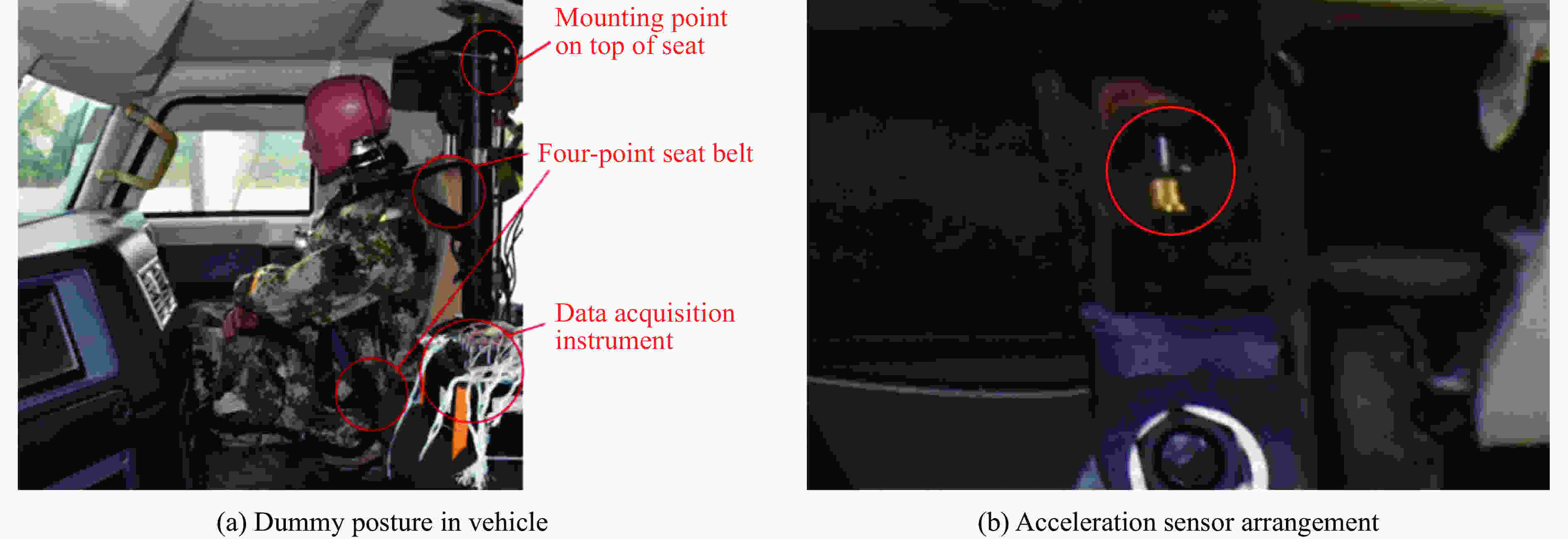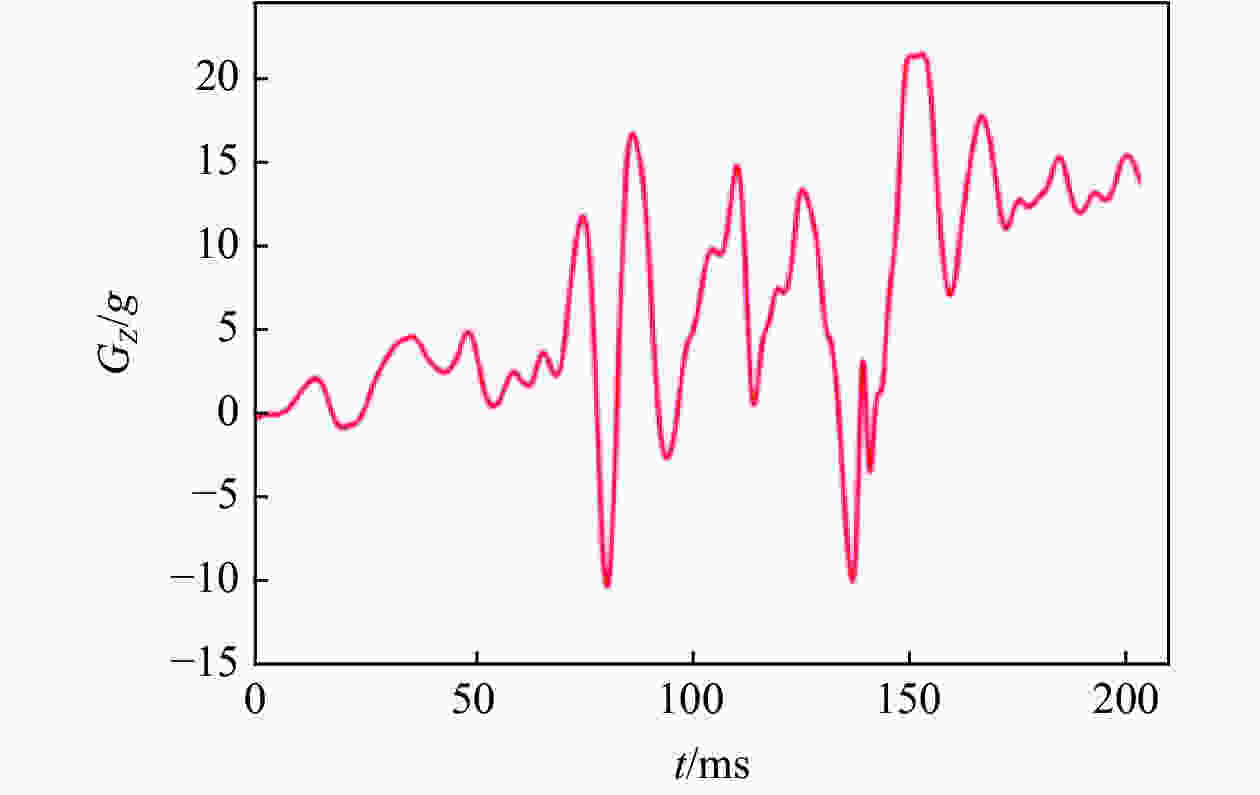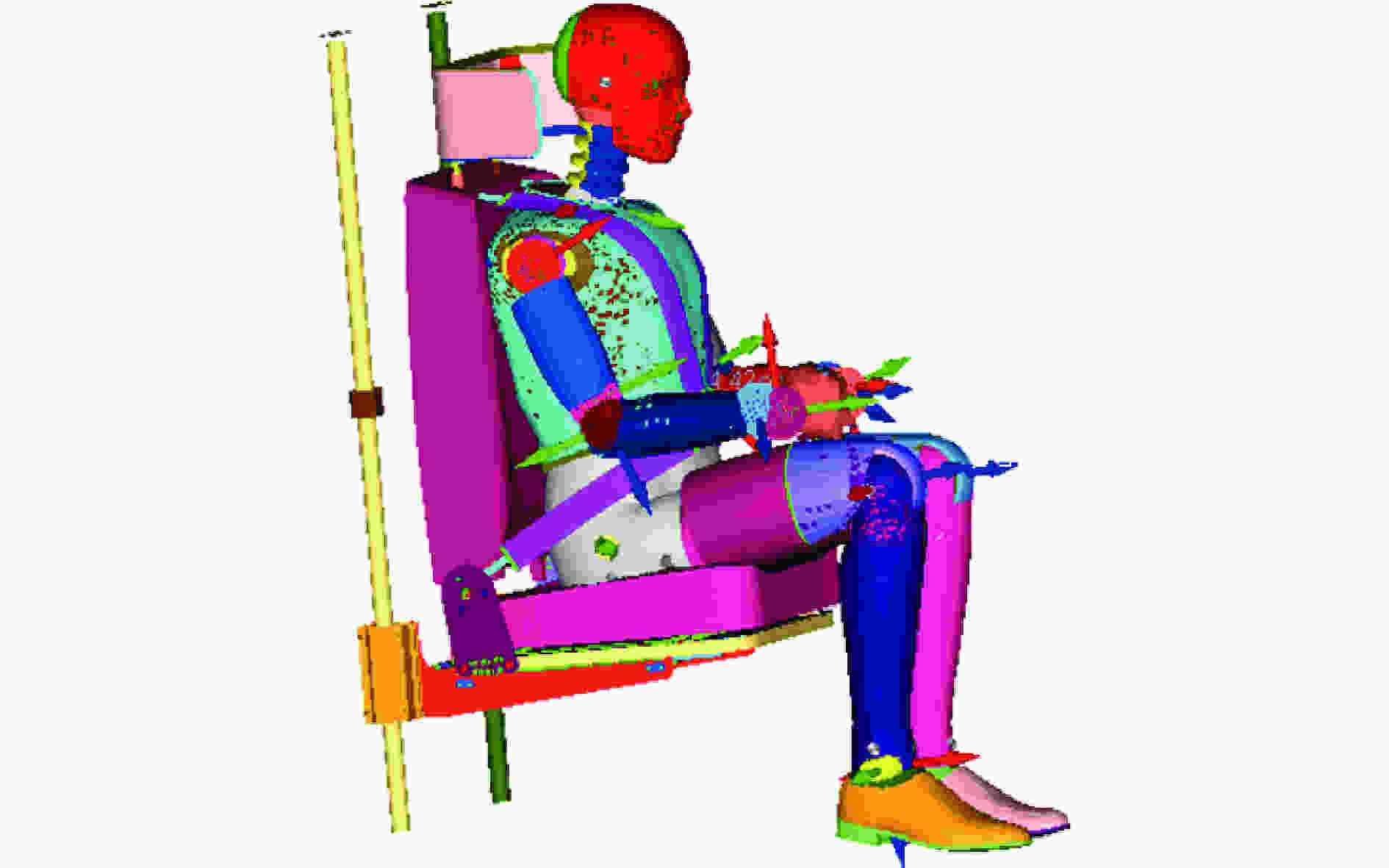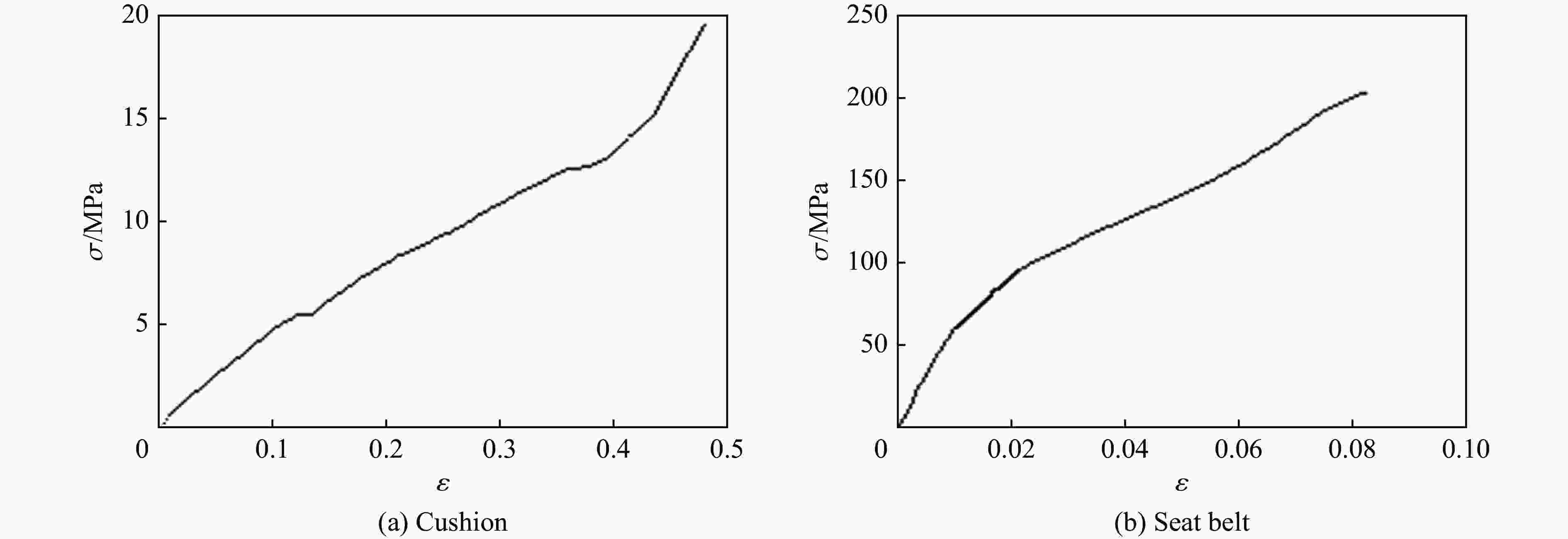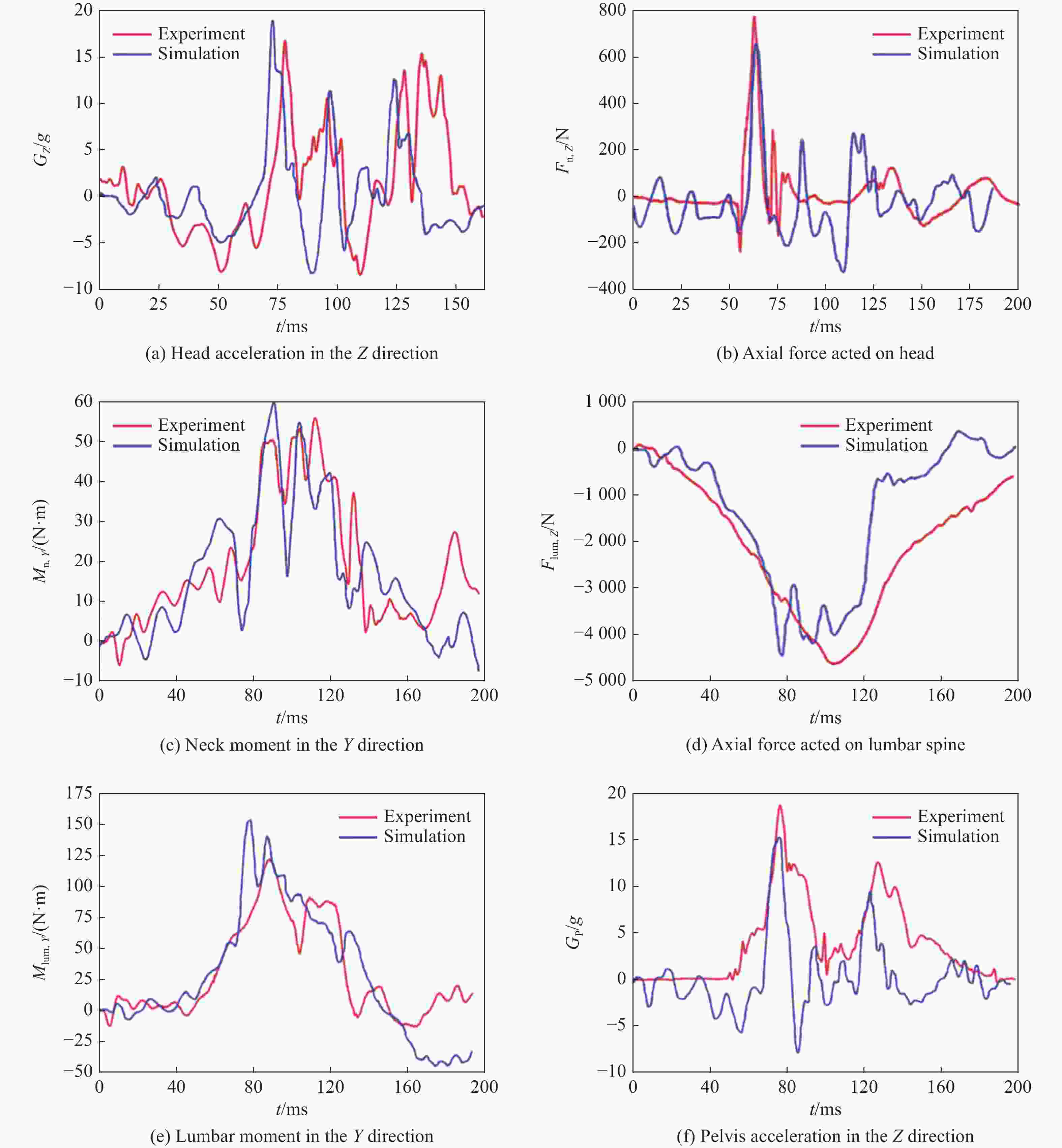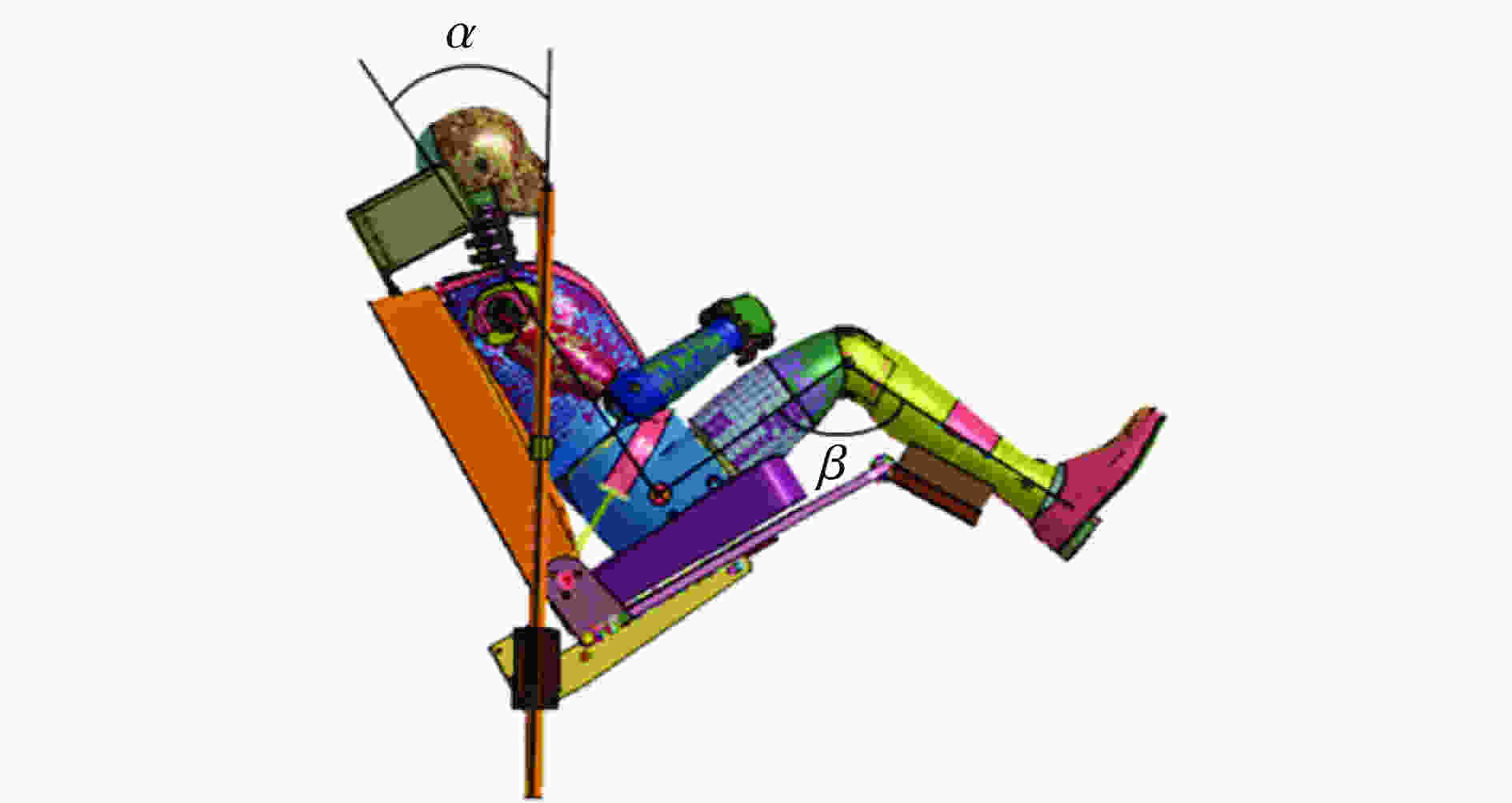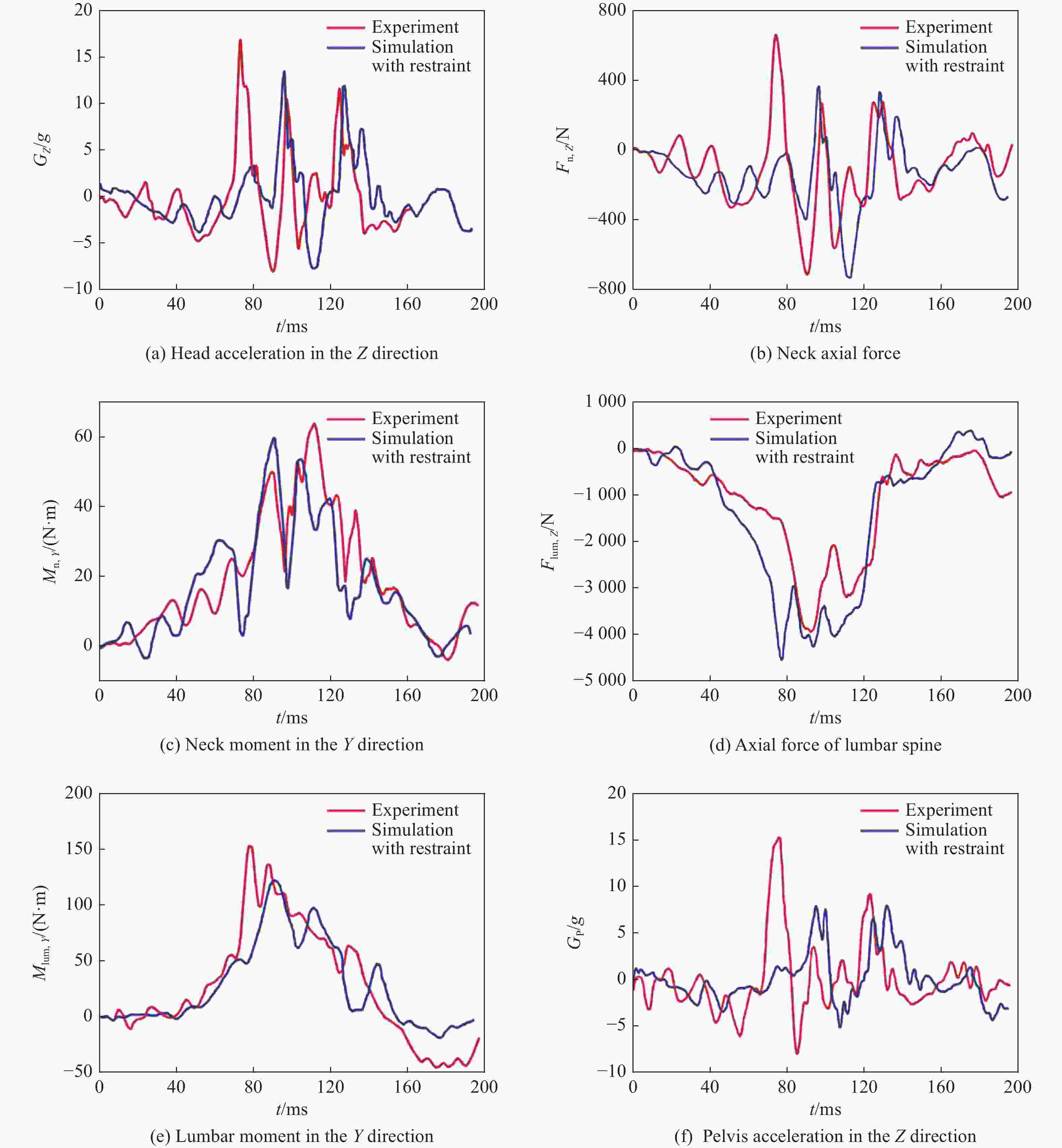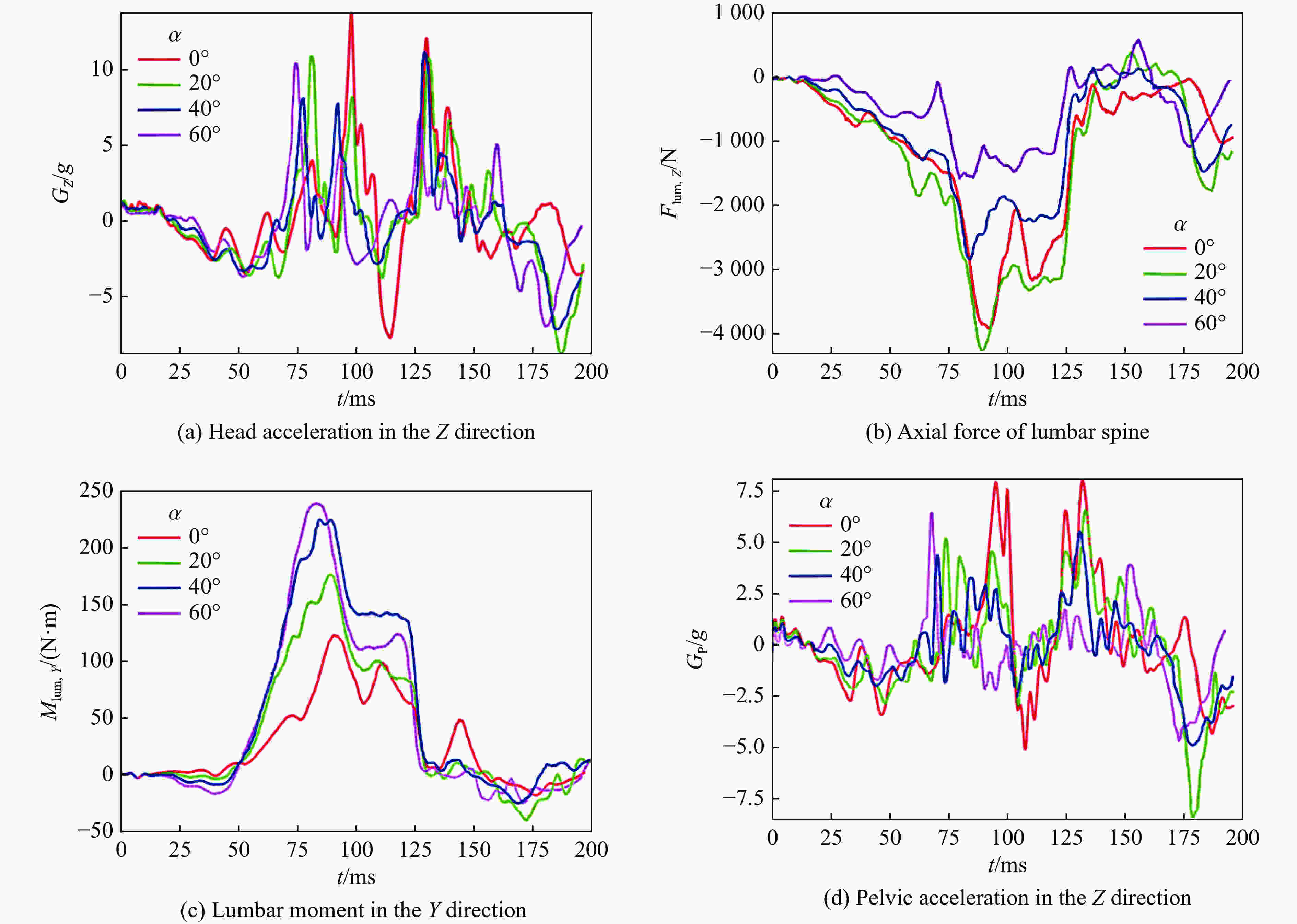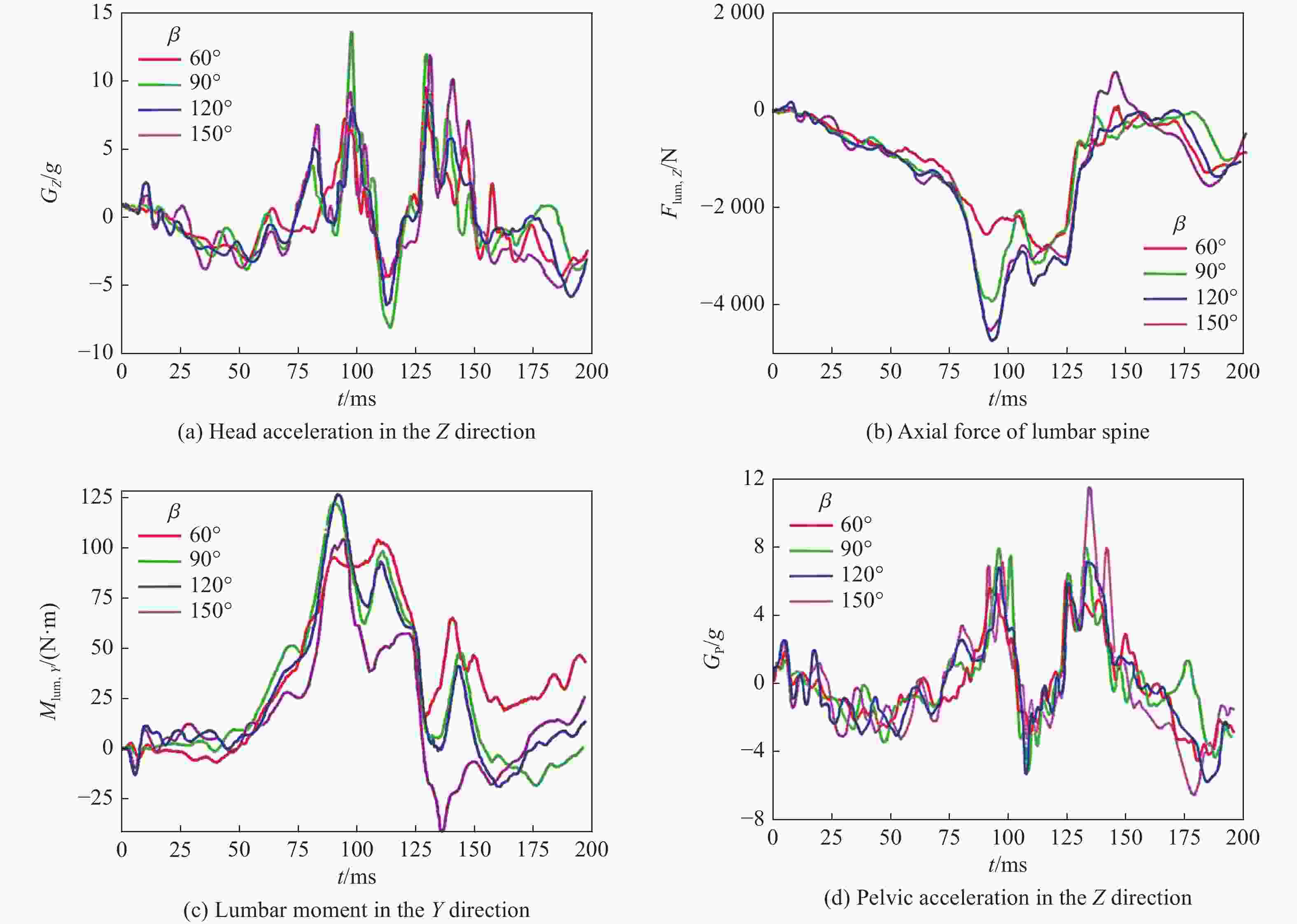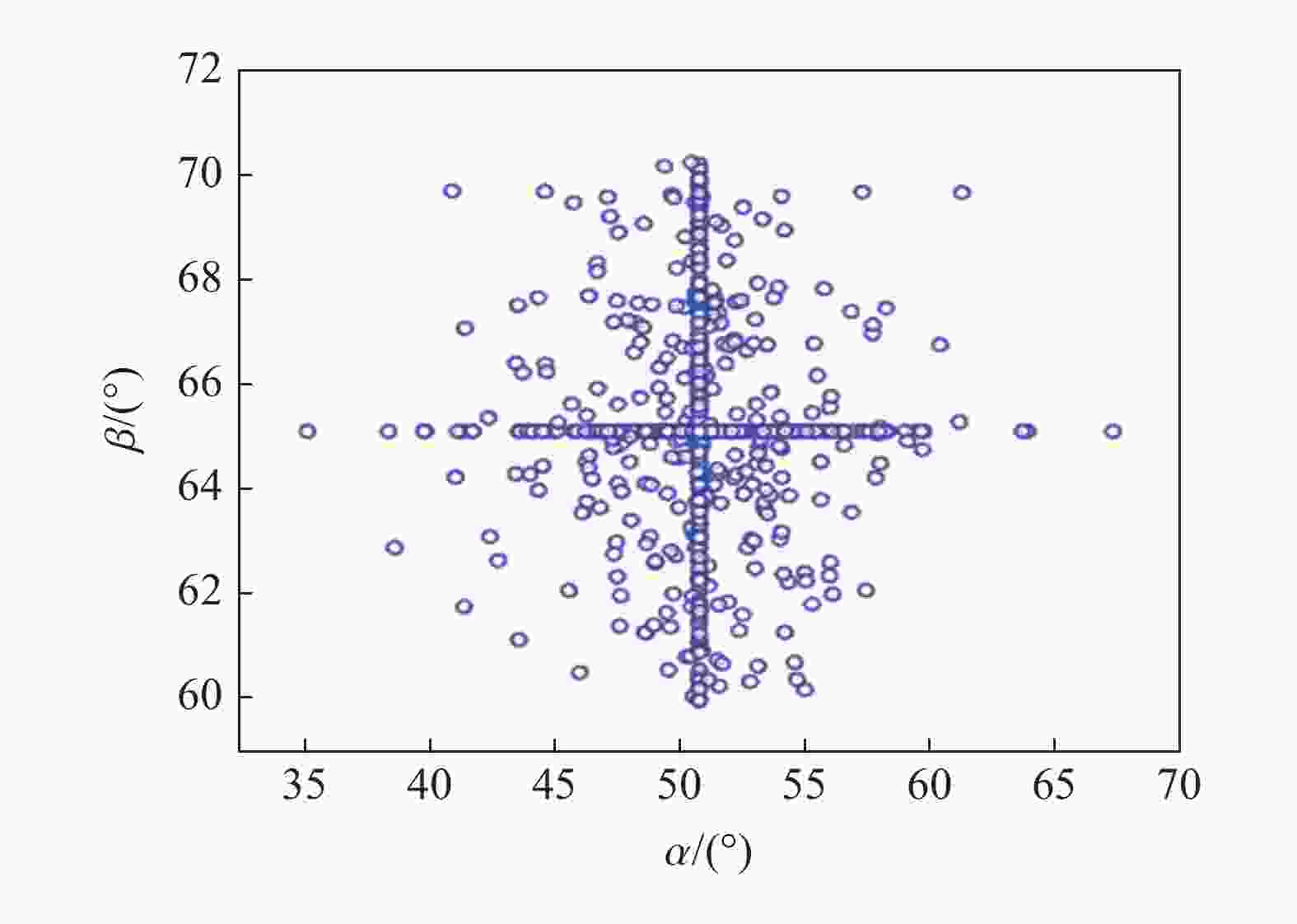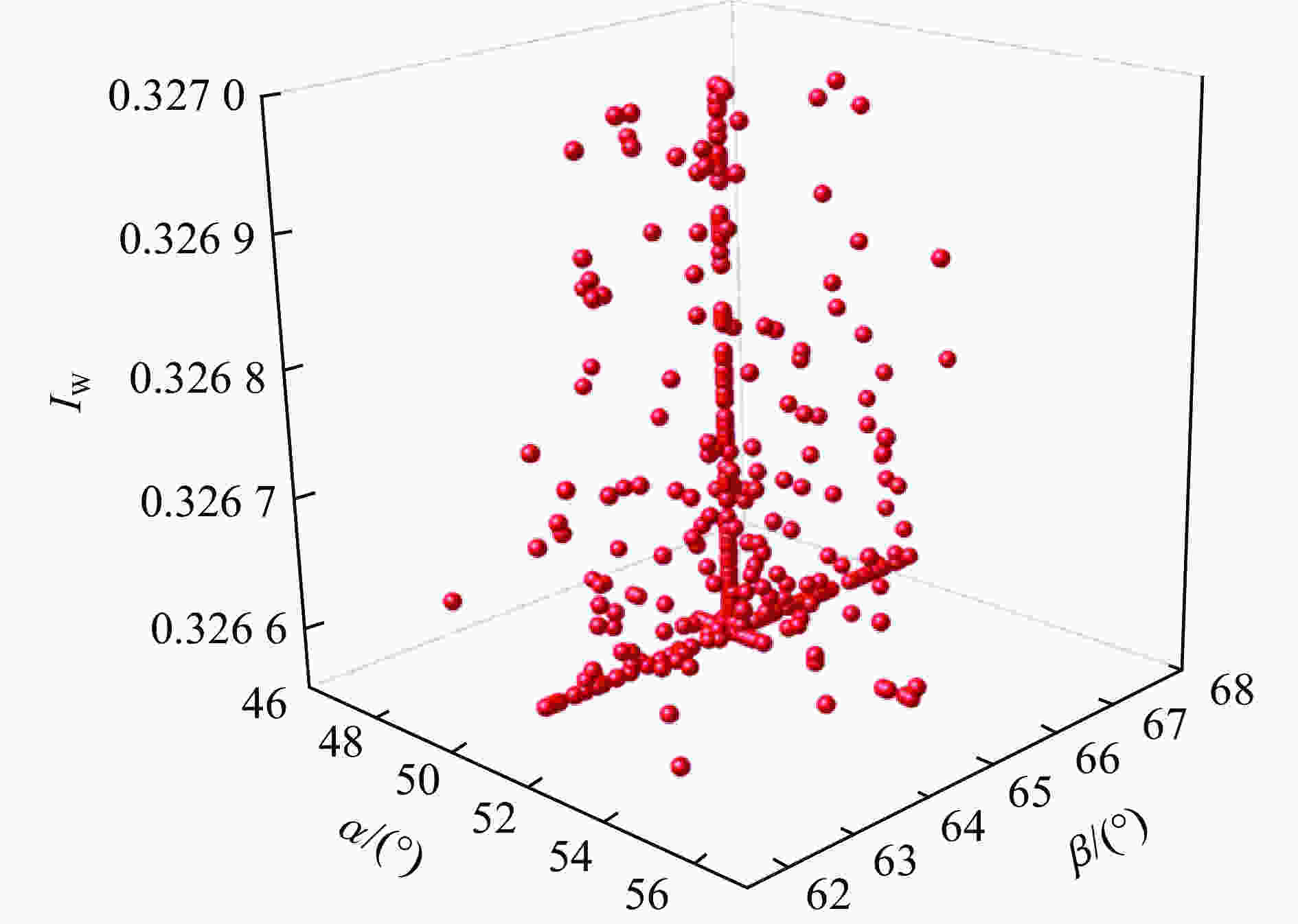Effects of different postures on crew damage under the impact of manned airdrop landing
-
摘要: 针对某军用车辆在1 m高度进行无缓冲平台空投实验,并建立座椅与乘员的模拟模型。利用实验获取的座椅安装点冲击信号作为模拟模型的输入数据,并通过实验结果与模拟结果的对比验证了该模型的可靠性。借鉴航空工程相关研究,提出了一种将各关键损伤指标加以归一化的权重评价指标—加权损伤准则(weighted injury criteria,WIC)。研究了乘员仰卧角度和大小腿夹角两个姿态参数对乘员损伤的影响,并以WIC为优化目标,利用遗传算法完成参数优化工作。研究发现:对乘员小腿运动进行约束能降低乘员整体损伤响应,乘员对抗着陆冲击的最佳姿态为仰卧角47°~56°、大小腿夹角62°~68°。Abstract: For a military vehicle, an unbuffered platform airdrop test was performed at a height of 1 m. And a seat-crew model was built. The impact signals at the seat installation point were obtained by the test. The obtained signals were used as the input of the simulation model, and the reliability of the model was verified by comparing the test and simulation data. Based on the aeronautical engineering related research, a weight evaluation index named weighted injury criteria (WIC) was presented by normalizing each key damage index. The influence of two posture parameters, namely the crew’s supine angle and the angle between the calf and the thigh, on the crew’s injury was studied. With the WIC as the optimization target, the genetic algorithm was used to obtain the optimized parameters. The study finds that to restrain the motion of the crew’s calf can reduce his overall injury response. The optimal posture of the crew against the landing impact is the supine angle range from 47° to 56°, and the angle between the upper and lower legs is from 62° to 68°.
-
Key words:
- manned airdrop /
- landing impact /
- crew posture /
- weight evaluation index /
- weighted injury criteria
-
表 1 不同部位伤害标准和限值
Table 1. Injury standards and threshold values for different parts
部位 损伤标准 注解 损伤指标 损伤指标限值 头部 GX/g 头部X向加速度 GX,lim/g 26 GZ/g 头部Z向加速度 GZ,lim/g 20 颈部 Fn,Z/kN 颈部压缩轴向力 Fn,Z,lim/kN −1.3 Mn,Y/(N·m) 颈部力矩 Mn,Y,liml/(N·m) 135 Nij 轴向力和弯曲力矩线性合成准则 1 腰椎 Flum,Z/kN 腰椎轴向力 Flum,Z,lim/kN 8 Mlum,Y/(N·m) 腰椎Y向弯矩 Mlum,Y,lim/(N·m) 400 盆骨 Gp/g 盆骨Z向加速度 λdri 动态响应指数 λdri,lim 13.4 表 2 主要结构材料参数
Table 2. Main structural material parameters
材料 密度/(g·cm−3) 弹性模量/GPa 泊松比 屈服极限/MPa 拉伸失效应变 Q235 7.8 210.0 0.31 235.0 0.24 泡沫 0.2 28.3 0.40 19.7 0.50 A3003H14铝 2.7 70.0 0.30 110.0 0.10 表 3 实验与模拟数据对比
Table 3. Comparison of experimental and simulated data
方法 GZ/g Fn,Z/kN Mn,Y/(N·m) Flum,Z/kN Mlum,Y/(N·m) Gp/g 实验 16.7 0.79 56.7 4.65 126.7 17.9 模拟 18.8 0.76 63.9 4.52 151.2 15.6 相对误差/% 12.6 3.5 12.7 2.6 19.3 12.8 表 4 设计变量选取
Table 4. Selection of design variables
设计参数 采样点 α/(°) 0 10 20 30 40 50 60 70 β/(°) 60 90 120 150 表 5 小腿有、无约束模拟数据对比
Table 5. Comparison of simulation data between the calf with and without restraint
模拟条件 GX/g GZ/g Fn,Z/kN Mn,Y/(N·m) Flum,Z/kN Mlum,Y/(N·m) Id Iw 小腿无约束 10.2 18.80 0.763 63.9 4.52 157 3.76 0.536 0 小腿有约束 8.7 15.38 0.715 59.3 3.92 122 3.66 0.411 6 相对差值/% 14.7 18.2 5.7 7.2 13.4 21.8 2.7 23.2 表 6 不同仰卧角度的仿真数据对比
Table 6. Comparison of simulation data of different supine angles
α/(°) GX/g GZ/g Fn,Z/kN Mn,Y/(N·m) Flum,Z/kN Mlum,Y/(N·m) Id Iw 0 8.7 15.38 0.593 0.318 3.92 112.8 3.46 0.411 6 10 9.31 14.05 0.558 0.291 4.45 149.0 3.18 0.425 3 20 10.88 13.96 0.575 0.260 4.28 176.2 3.1 0.432 6 30 13.22 12.33 0.565 0.208 3.46 223.9 1.84 0.410 5 40 15.95 11.20 0.587 0.128 2.85 225.0 1.82 0.385 6 50 13.05 11.70 0.545 0.104 2.27 202.0 1.85 0.343 6 60 13.80 11.89 0.564 0.080 1.79 239.0 1.47 0.346 6 70 13.90 10.30 0.5249 0.090 1.43 279.0 1.49 0.349 3 表 7 不同大小腿夹角的空投冲击工况模拟数据对比
Table 7. Comparison of simulation data among airdrop impact conditions with different angles between the calf and the thigh
β/(°) GX/g GZ/g Fn,Z/kN Mn,Y/(N·m) Flum,Z/kN Mlum,Y/(N·m) Id Iw 60 9.8 11.66 0.491 0.247 3.87 104.3 3.55 0.365 2 90 8.7 15.38 0.593 0.318 3.92 122.8 3.66 0.411 6 120 11.8 13.2 0.566 0.316 4.74 127.9 3.82 0.435 5 150 8.39 13.47 0.528 0.270 4.53 105.5 4.42 0.405 6 表 8 优化结果和仿真结果的对比
Table 8. Comparison of optimization results and simulation results
项目 GX/g GZ/g Fn,Z/kN Mn,Y/(N·m) Flum,Z/kN Mlum,Y/(N·m) Id Iw 优化结果 0.4987 0.103 1 1.70 201 1.35 0.326 优化后模拟结果 13.3 10.4 0.5158 0.106 0 1.72 229 1.04 0.328 误差/% 3 2.8 1.2 13.9 22.9 0.6 表 9 优化后方案与原始方案的对比
Table 9. Comparison between the optimized solution and the original solution
项目 GX/g GZ/g Fn,Z/kN Mn,Y/(N·m) Flum,Z/kN Mlum,Y/(N·m) Id Iw 初始值 10.2 18.8 0.720 2 0.570 4.52 157 3.76 0.536 优化后模拟结果 13.3 10.4 0.515 8 0.106 1.72 229 1.04 0.328 相对差值/% −30 44.7 20.4 81.4 61.9 −45 72 38.8 -
[1] 刘鑫. 基于气囊缓冲的载人空降乘员防护理论与方法[D]. 长沙: 湖南大学, 2009. DOI: 10.7666/d.d146725. [2] 刘鑫, 张志勇. 基于气囊缓冲的载人空降乘员防护装置优化设计 [J]. 机械工程学报, 2010, 48(21): 168–174. DOI: 10.3901/JME.2012.21.168.LIU X, ZHANG Z Y. Optimal design of passenger’s protection devices in manned airdrop based on airbag cushion [J]. Journal of Mechanical Engineering, 2010, 48(21): 168–174. DOI: 10.3901/JME.2012.21.168. [3] STAPP J P, TAYLOR E R. Space cabin landing impact vector effects on human physiology [J]. Aerospace Medicine, 1964, 35: 1117–1133. [4] 成自龙, 韩延方, 曾文艺, 等. 人体坐姿着陆冲击(+G z)耐限区间的研究 [J]. 航天医学与医学工程, 1997, 10(5): 340–343. DOI: 10.16289/j.cnki.1002-0837.1997.05.008.CHENG Z L, HAN Y F, ZENG W Y, et al. Human tolerance to landing impact (+G z) in sitting position [J]. Space Medicine and Medical Engineering, 1997, 10(5): 340–343. DOI: 10.16289/j.cnki.1002-0837.1997.05.008. [5] 刘炳坤, 王宪民, 王玉兰, 等. 不同体位着陆冲击时人体的动态响应 [J]. 航天医学与医学工程, 2001, 14(2): 121–123. DOI: 10.3969/j.issn.1002-0837.2001.02.010.LIU B K, WANG X M, WANG Y L, et al. Human dynamic response to landing impact in selected body orientations [J]. Space Medicine and Medical Engineering, 2001, 14(2): 121–123. DOI: 10.3969/j.issn.1002-0837.2001.02.010. [6] 冯宇, 于广春, 吴增斌, 等. 某轮式空降战车模拟着地冲击试验方法研究 [J]. 车辆与动力技术, 2019(2): 62–64. DOI: 10.16599/j.cnki.1009-4687.2019.02.012.FENG Y, YU G C, WU Z B, et al. Research on the simulated landing impact test method of a wheeled airborne fighting vehicle [J]. Vehicle and Power Technology, 2019(2): 62–64. DOI: 10.16599/j.cnki.1009-4687.2019.02.012. [7] 俞彤, 王显会, 周云波, 等. 爆炸环境下车辆地板加速度对乘员小腿损伤的影响 [J]. 科学技术与工程, 2018, 18(21): 339–344. DOI: 10.3969/j.issn.1671-1815.2018.21.053.YU T, WANG X H, ZHOU Y B, et al. The effects of vehicle floor acceleration on the damage of occupant's tibia in explosive environment [J]. Science Technology and Engineering, 2018, 18(21): 339–344. DOI: 10.3969/j.issn.1671-1815.2018.21.053. [8] 梁锐, 黄世霖, 杜汇良, 等. 高G值复合着陆冲击下头、颈部损伤成因 [J]. 中国临床康复, 2005, 9(25): 28–30. DOI: 10.3321/j.issn:1673-8225.2005.25.014.LIANG R, HUANG S L, DU H L, et al. Causes of head and neck injury under high G landing impact [J]. Chinese Journal of Clinical Rehabilitation, 2005, 9(25): 28–30. DOI: 10.3321/j.issn:1673-8225.2005.25.014. [9] North Atlantic Treaty Organization. Procedures for evaluating the protection level of armored vehicles-mine threat: AEP-55: Volume 2[S]. Brussels: Allied Engineering Publication, 2011. [10] 通过载人航天器发射、中止、着陆引起的伤害来确定NASA风险准则[J]. 载人航天信息, 2015(2): 1−13.Determine NASA risk criteria through injuries caused by manned spacecraft launch, suspension, and landing[J]. Manned Spaceflight Information, 2015(2): 1−13. [11] ECE UN. Uniform provision concerning the approval of vehicles with regard to the emission of pollutants according to engine fuel requirements [J]. UN ECE Regulation, 2005(83). [12] VIANO D C, AREPALLY S. Assessing the safety performance of occupant restraint systems [M]. DOI: 10.4271/902328. [13] BROWN W K, ROTHSTEIN J D, FOSTER P. Human response to predicted Apollo landing impacts in selected body orientations [J]. Aerospace Medicine, 1966, 37(4): 394–398. [14] TABIEI A, LAWRENCE C, FASANELLA E L. Validation of finite element crash test dummy models for predicting orion crew member injuries during a simulated vehicle landing: NASA TM-2009-215476 [R]. 2009. [15] 王心怡, 刘晓颖, 陈聪, 等. 跌落工况下的人体腰椎损伤风险的几种影响因素 [J]. 汽车安全与节能学报, 2018, 9(2): 178–185. DOI: 10.3969/j.issn.1674-8484.2018.02.008.WANG X Y, LIU X Y, CHEN C, et al. Factors for affecting risk of human lumbar spine injuries under dropping conditions [J]. Journal of Automotive Safety and Energy, 2018, 9(2): 178–185. DOI: 10.3969/j.issn.1674-8484.2018.02.008. [16] SIMPSON T M, MAUERY T M, KORTE J J, et al. Kriging models for global approximation in simulation-based multidisciplinary design optimization [J]. AIAA Journal, 2001, 39(12): 2233–2241. DOI: 10.2514/2.1234. -






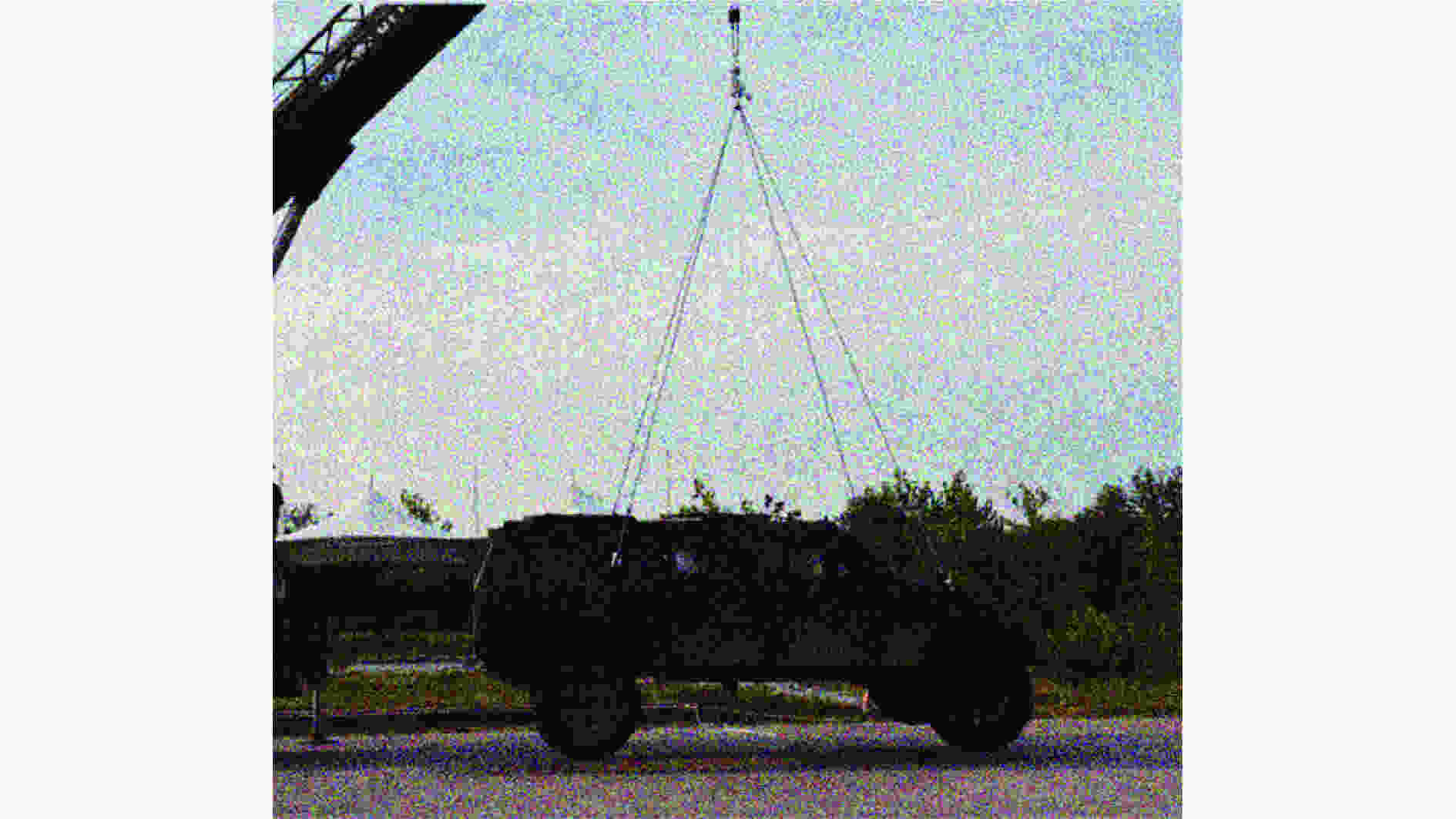
 下载:
下载:
